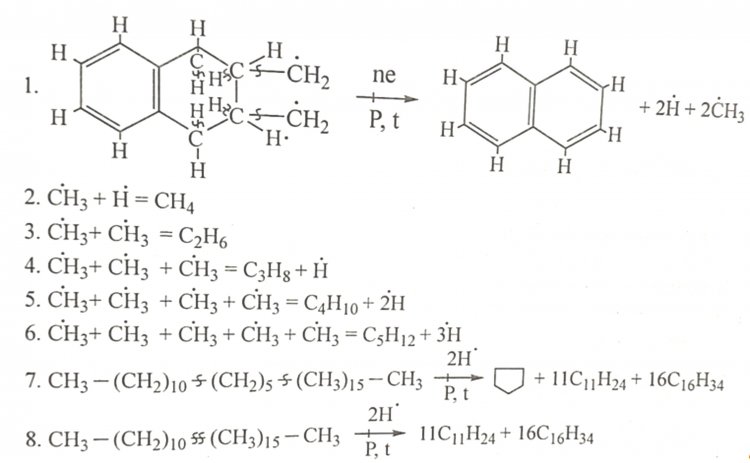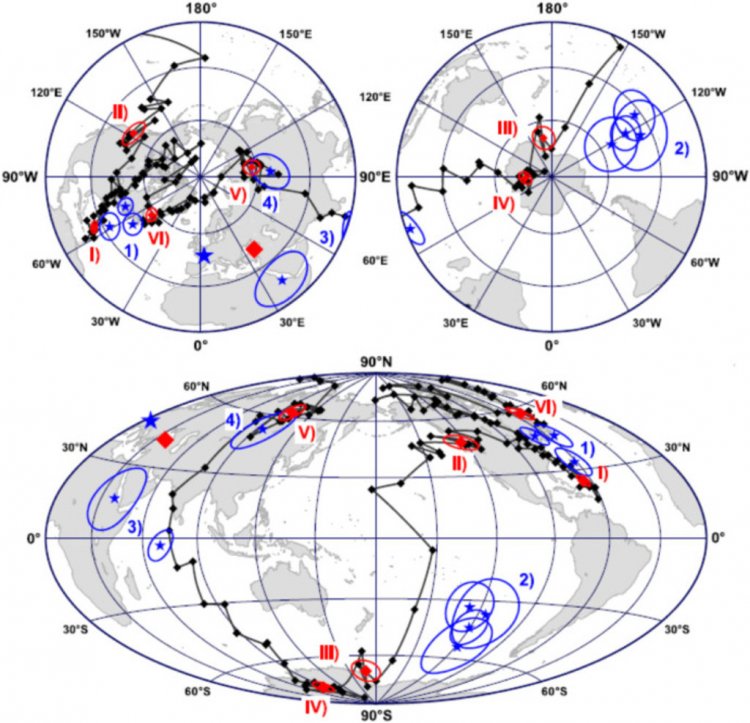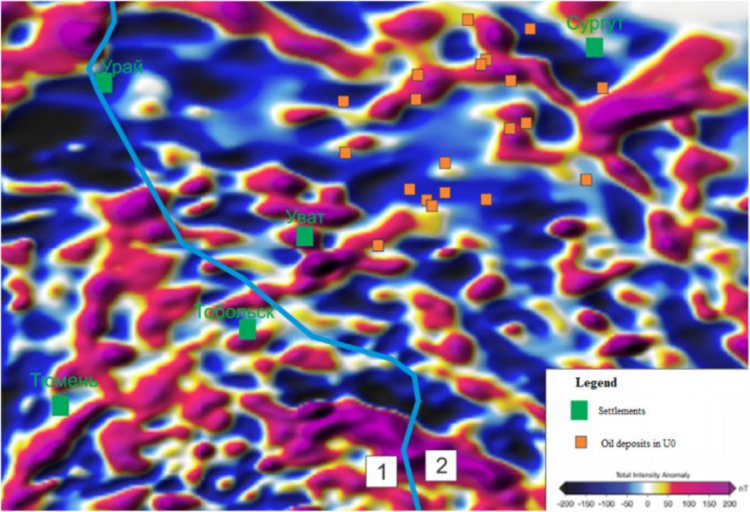Tyumen scientists develop the ideas of Corresponding Member of the Russian Academy of Sciences I.I. Nesterov, which have become the theoretical basis of fundamental research and experimental work in the view of studying the process of formation of oil fields
The transition from traditional to renewable energy sources requires new technological solutions. Experts propose original approaches to identify oil and gas fields, taking into account the fact that the formation of oil and gas is based on various processes. For example, it is important to study the mechanism and regularities of formation (interaction of intramolecular or spin fields), the structure and composition of hydrocarbons and heterounits.
Scientists of the Tyumen Industrial University (TIU, Tyumen) have been working for many years to study the processes of formation of oil fields in oil-bearing rocks. The conducted experimental and analytical studies confirm the innovativeness of the fundamental ideas laid down by Corresponding Member of the Russian Academy of Sciences I.I. Nesterov, which preserve the innovative resource and relevance. In particular, TIU specialists consider the phenomenon of spin catalysis and its role in the processes of oil and gas generation, study the influence of natural geomagnetic fields on the process of hydrocarbon generation, and propose a fundamentally new set of search criteria for oil deposits in oil-producing deposits (in the Bazhenov Formation).
Andrey Alexandrovich Ponomarev, Assistant at the Department of Geology of Oil and Gas Fields at the Institute of Geology and Oil and Gas Production of Tyumen Industrial University (Tyumen), spoke about the concept of oil fields in the Bazhenov Formation, put forward by a team of researchers at TIU, and the contribution to geology of his teacher and mentor, Corresponding Member of the Russian Academy of Sciences Ivan Ivanovich Nesterov, whose scientific heritage is carefully preserved and developed by the current generation of students.
What are the priorities and problems of atomic and molecular geology today and how can their solution (including the research you are conducting) contribute to the development of oil and gas geology in the near future?
“Regarding atomic or molecular geology – this is a rather loud name that our Teacher Ivan Ivanovich Nesterov could afford. I think that geology, or rather geochemistry itself is atomic and molecular, but as for the fundamental ideas about the processes of oil and gas generation in oil-producing rocks and the processes affecting the geochemical evolution of oil – there are certainly questions here. The task and priority direction of oil and gas geochemistry are, as always, the accumulation and creation of reliable knowledge about the processes of formation of oil and gas fields. The current trend in the oil and gas industry is the digitalization of all and everything, but I think that before digitalizing something, first, the digitalization process must be understandable.
Currently, the process of formation of oil and gas deposits is described according to the biogenic theory – in general, we agree with it. But we believe that the specific process of oil and gas generation deserves additional study. In basin modeling, chemical kinetic modeling based on the Arrhenius equation is used to describe the process of oil and gas generation from organic matter. In a simplified sense, it implies that the rate of chemical reactions increases 2-4 times when the temperature increases by 10 degrees Celsius.
I am not a chemist – I am a geologist, and with my basic knowledge of chemistry, it does not fit in my head how high-energy carbon-carbon bonds can break, corresponding to the breaking temperature of 300 degrees Celsius or more in organic matter at a reservoir temperature not exceeding 120-140 degrees Celsius. The same opinion was shared by our Teacher Nesterov, so back in the 20th century, he proposed his own theory that describes the process of oil and gas generation due to the activation of radical chain reactions (see Fig. 1).
Figure 1. Scheme of formation of gaseous and liquid hydrocarbons from solid organic matter with paramagnetic centers located at the ends of aliphatic chains of molecules.
То есть в пласте при определенных условиях внешней среды (пластовой температуре, давлении, магнитной обстановке) начинают протекать экзотермические реакции с выделением тепла, достаточного для разрыва высокоэнергетических связей углерод-углерод (-С-С-) в органическом веществе. Но касаемо этой теории было проведено не так много экспериментов, в своих же исследованиях мы провели дополнительные эксперименты, которые показывают, что количество сгенерированных из органического вещества углеводородов в присутствии магнитного поля выше, чем без магнитного поля. Точно объяснить этот процесс пока что мы не можем, но мы предполагаем участие в этом спинового катализа (это процесс увеличения скорости химических реакций в магнитных полях). Мы думаем, что в магнитных полях интенсивность нефтегазогенерации возрастает либо за счет снижения энергии активации в высокоэнергетических связях -С-С-, либо за счет многократного увеличения скорости химических реакций (второе исходя из логики химико-кинетического моделирования).
Решение этой проблемы – оценки роли геомагнитных полей в процессах нефтегазогенерации – может в значительной степени повысить эффективность геологоразведочных работ на нефть и газ. Первую ступень в этом направлении мы преодолели – выделили поисковые критерии для залежей нефти в баженовской свите (то есть в нефтематеринской породе – вопрос миграции нефти мы не рассматривали)», – дал аргументированный ответ Андрей Пономарев.
Член-корреспондент РАН Иван Иванович Нестеров – ведущий российский специалист в области геологии нефтяных и газовых месторождений, основал в Тюмени геологическую школу по разработке инженерных технологий на базе изучения геологических процессов. В вопросах изучения процессов образования нефти и газа опирался на труды академика А.Л. Бучаченко (который известен открытием спинового катализа), потому что, по мнению Андрея Пономарева, «видел в них рациональное зерно, необходимое для объективного описания процессов нефтегазогенерации».
По словам ученого, «явление спинового катализа простым языком можно объяснить как значительное увеличение скорости химических реакций во внешнем магнитном поле, также оно распространяется и на химические реакции с участием стабильных изотопов, обладающим магнитным моментов. Если не ошибаюсь, А.Л. Бучаченко выделил порядка 10 таких изотопов, а последние исследования Ивана Ивановича свидетельствуют о том, что магнитным эффектом могут обладать еще несколько изотопов, так как по своей атомной конфигурации они очень похожи на те 10 изотопов» (об этом в статье Нестеров Н.И., Александров В.М., Пономарев А.А., Заватский М.Д., Лободенко Е.И., Кобылинский Д.А., Кадыров М.А. Экспериментальные исследования радикальных реакций преобразования углеводородного сырья. Известия высших учебных заведений. Нефть и газ. 2019;(4):57-69. https://doi.org/10.31660/0445-0108-2019-4-57-69).
Какую роль спиновый катализ играет в процессах нефтегазогенерации?
«Насчет роли спинового катализа и изотопов с магнитным эффектом в нефтегазовой геологии – этот аспект практически не изучен. Во всем мире этим вопросом, наверное, занимается только наш научный коллектив (ученики Нестерова). Всё на уровне гипотезы. Постараюсь объяснить простым языком: в настоящее время в нефтегазовой геологии наиболее распространена биогенная теория – за миллионы лет накапливалось органическое вещество на дне водоемов, далее происходил процесс осадконакопления терригенного материала, все это дело погружалось – происходило повышение температуры и давления и, соответственно, в результате этого сложные твердые углеводороды превращались в более простые жидкие и газообразные. Но проблема в том, что никто еще не доказал в лабораторных условиях возможность нефтегазогенерации при температурах эквивалентным пластовым (80-140 градусов по Цельсию). Все имеющиеся эксперименты показывают процесс генерации углеводородов в лабораторных условиях при температурах выше 300 градусов по Цельсию. И геохимики, и математики говорят, что высокие температуры компенсируются длительностью геологического времени. Мы с этим не согласны и считаем, что нужно искать дополнительные факторы внешней среды, оказывающие влияние на процесс нефтегазогенерации. Мы считаем, что геомагнитные поля оказывают непосредственное влияние на процесс нефтегазогенерации, и в магнитном поле интенсивность генерации возрастает. В геологических условиях дискретность геомагнитного поля обусловлена, во-первых, инверсией геомагнитных полюсов (напряженность геомагнитного поля на экваторе в два раза ниже, чем на полюсах); во-вторых, дизъюнктивными нарушениями, в которых происходят электромеханические эффекты при трении горных пород друг об друга, возможно, есть еще один фактор; в-третьих, смешивание пластовых вод разной минерализации при миграции. Влияние этих трех факторов на процессы нефтегазогенерации совершенно не изучено. Мы в своем исследовании рассмотрели первый фактор и нашли некоторые закономерности», – прокомментировал исследователь.
В чем в данном случае проявляется междисциплинарный аспект?
«Геохимиками-нефтяниками явление спинового катализа не изучалось. Этот вопрос связан с тем, что у нас колоссальные запасы нефти и газа в Российской Федерации, и до недавнего времени (пока не наступила проблема обводненности большинства месторождений) геологоразведочным работам уделялось не очень много внимания. Существующая биогенная теория вполне себе эффективно работала и выявляла новые месторождения. Сейчас настало время, когда геологоразведке нужна новая теория, которая может объяснить открытие существующих месторождений, а также открыть новые.
Иван Иванович был настоящим ученым и решил эту проблему еще до ее наступления, так сказать, оставил нам наследство в виде необходимости междисциплинарного изучения процессов нефтегазогенерации. Дело в том, что явление спинового катализа и свойства изотопов с магнитным моментом – это очень тонкая фундаментальная химия, в университетах геохимикам и нефтяникам такие знания не дают. Поэтому нужна коллаборация – нужно подключать в нефтегазовую геохимию специалистов по фундаментальной химии. Проблемы нефтегазовой геохимии уже сформулированы – нужно объяснять достоверно, при каких условиях возможен процесс нефтегазогенерации в пласте», – высказался ученый.
Говоря о перспективах применения спинового катализа, Андрей Пономарев отметил: «Иван Иванович говорил, что с помощью этих явлений можно создать принципиально новые материалы типа сверхпроводников или сверхпрочных наноматериалов, или сверхэффективные катализаторы. Секрет в том, что нужно использовать в исходном сырье стабильные изотопы с магнитным моментом».
Примечательно, что у профессора Нестерова большое количество учеников, и многие из них продолжают развивать идеи своего Учителя и занимаются фундаментальными исследованиями. Среди них – к.г.-м.н., заведующий кафедрой геологии месторождений нефти и газа Михаил Дмитриевич Заватский, область профессиональных интересов которого – наземные геохимические исследования при поиске залежей нефти и газа; аспирант ТИУ, директор компании ООО “ТюменьНефтеТехнологии” Марсель Алмазович Кадыров, который разрабатывает и производит химию для борьбы с АСПО и солеотложениями; к.г.-м.н., главный геолог ООО «Тандем», доцент ТИУ Вадим Михайлович Александров – принимает активное участие в изучении влияния геомагнитных полей на процессы генерации УВ.
Academician Ivan Ivanovich Nesterov and his student Andrey Ponomarev, 2018. Ivan Ivanovich visited the educational and scientific geochemical laboratory of TIU.
Following the scientific ideas of his mentor and supervisor, Andrey Ponomarev is now working with his colleagues from Tyumen Industrial University on issues related to the development of oil and gas geology.
“Since my first year as a student, I began to engage in scientific activity first under the guidance of Mikhail Dmitrievich Zavatsky, and when I entered graduate school, I was lucky enough to work under the guidance of Ivan Ivanovich Nesterov – he taught me not only non-standard scientific thinking but also real human friendship,” the Tyumen researcher confessed.
The young scientist pays attention to several important aspects; in particular, in his Candidate of Geological and Mineralogical Sciences dissertation Nuclear-electronic interactions in the formation of the fuel and energy potential of the Bazhenov Horizon.
“Firstly, I conducted additional experiments that support Nesterov’s idea of the influence of external magnetic fields on the process of oil and gas generation. Secondly, I tried to criticize the modern approach to chemical kinetic modeling, using the criticism of biogenic theory from the position of abiogenic (inorganic) theory. Thirdly, I revealed the relationship between oil deposits in the Bazhenov Formation and magnetic anomalies on the EMAG2 map. And fourthly (but here we are talking about the geochemical evolution of oil), I showed to what extent the geochemical characteristics of the oil can change as a result of the discreteness of the magnetic field – this can help in assessing the migration of oil into traps from oil-producing deposits. There is an article on this topic that is in the second round of reviewing in an international thematic journal,” Andrei Ponomarev pointed out.
As an object of research, Ponomarev considered samples of core and oil from the Bazhenov Formation, which is the main geological object of unconventional oil reserves in Western Siberia.
As the scientist noted, its uniqueness lies in the fact that “it is an oil source. According to the modern concept, it was from the Bazhenov Formation that oil migrated up the section and accumulated in traps. On what sediments should the processes of oil and gas generation be studied, if not on the oil-producing sediments of the Bazhenov Formation?! Samples of rocks of the Bazhenov Formation were used as the object of research in the issue of oil and gas generation. And in the question of the geochemical evolution of oil, we chose Bazhenov oil, because the processes of oil generation were studied according to the Bazhenov Formation. To study the influence of geomagnetic fields on the process of geochemical evolution, any oil would be suitable at the first stage, although we assume that geomagnetic fields have different effects on the geochemical evolution of various oils, depending on the composition of the oil. This still needs to be studied, so far we have few materials.”
To trace how the geochemical characteristics of the Bazhenov Formation oil change under the electromagnetic influence, the Tyumen researcher recorded changes in the component and isotopic composition and estimated the concentration of paramagnetic centers in asphaltenes. The selection of the optimal temperature for studying the process of oil and gas generation in rocks was carried out using computer X-ray microtomography.
“If we see, according to tomography data, newly formed cracks as a result of heating of the oil-producing rock, then we say that the cracks have formed as a result of oil and gas generation. Computed tomography in our work was used indirectly – it helped to choose the optimal temperatures for experimenting to study the influence of the magnetic field on the processes of oil and gas generation. This is not a new approach, but just one of many approaches to using computer microtomography in oilfield geology,” Andrey Ponomarev clarified.
What role did EMAG2 maps (maps of magnetic anomalies of the planet) play in the research?
“EMAG2 cards are a completely different story. As I have already said, the intensity of the geomagnetic field at the geomagnetic equator is 2 times lower than at the poles. It is also known that over the past 80 million years, 183 geomagnetic reversals have occurred on our planet – our geomagnetic poles “walked” around the planet in a chaotic manner. Reconstruction of geomagnetic reversals is a time-consuming and, I suppose, expensive thing. In a literary review, I found only the Laschamp geomagnetic inversion reconstruction (see Fig. 2).
Figure 2. Reconstruction of the Laschamp geomagnetic excursion
Despite this, it is known that magnetic anomalies on the EMAG2 map are the result of geomagnetic inversions that occurred in the past. In this regard, we decided to analyze the regularities of the placement of oil deposits in the Bazhenov Formation and the values of magnetic anomalies on the EMAG2 map, and as a result, it turned out that the deposits are characterized by values of magnetic anomalies from -100 to 100 nT. Of course, other geological conditions are also necessary for the formation of deposits, for example, the content of organic carbon and reservoir temperatures – these parameters allowed us to distinguish 2 zones: promising and unpromising in terms of oil content. We have mapped these zones on the EMAG2 map (see Fig. 3) and developed search criteria. We have established that oil deposits in the Bazhenov Formation are characterized by reservoir temperature values greater than 70 degrees Celsius, organic carbon content (Corg) greater than 4%, and magnetic anomaly values according to EMAG2 maps from -100 to 100 nT. Nothing less than this allows us to conclude that there may also be oil deposits in the Bazhenov Formation in the Uvat area in the Tyumen Oblast,” the scientist informed in detail.
Figure 3. Magnetic anomalies and oil deposits in the Bazhenov Formation: 1, non-promising oil-bearing capacity; 2, promising oil-bearing zone.
Moreover, scientists have used not only the results of laboratory studies but also directly geochemical and geophysical characteristics of open oil fields in the Bazhenov Formation. As Andrey Ponomarev emphasized, “this allows us to identify quite specifically the areas that are promising from the standpoint of the oil content of the Bazhenov Formation.”
To date, TIU specialists continue to study the process of spin catalysis, in the future planning to attract geophysicists to their research team.
“We will be able to use magnetic exploration to judge the processes of oil and gas generation in the Bazhenov Formation or other oil-producing deposits. Well, I also think that when the influence of geomagnetic fields on the geochemical evolution of oil is studied in detail, it will be possible to more accurately carry out inter-layer correlations of the oil-oil type and judge how oil from the oil source rock got trapped, or even make a radically opposite conclusion that there is no migration, and oil is formed directly in the layers in which it lies,” the young scientist aims.
Currently, researchers from Tyumen Industrial University are actively cooperating with colleagues from Kazan Federal University; in particular, with Professor Marat Revgerovich Gafurov. Young scientists from Tyumen are full of innovative ideas and expect support for their research projects from state funds.
“I would like to thank our entire team of scientists: Vadim Mikhailovich Alexandrov, Marcel Almazovich Kadyrov, Mikhail Dmitrievich Zavatsky, Danil Aleksandrovich Kobylinsky, Marat Revgerovich Gafurov. And also, to emphasize the merits of the leadership of the Tyumen Industrial University in the person of Rector Veronika Vasilyevna Efremova and Vice-Rector for Science Yuri Vladimirovich Vaganov for supporting young scientists.
I would like to express my special gratitude to the World Sci Publ company in the person of Marcel Almazovich Kadyrov for striving to bring domestic scientists to the world leaders in scientometric indicators – without this company, we would not have been able to familiarize the world scientific community with the results of our research. I would like to express my gratitude to the Innovation Promotion Fund and the Russian Foundation for Basic Research, which no longer exists, for the financial support of our scientific endeavors,” Andrei Ponomarev expressed special gratitude for the help and support of scientific research.
Thus, the fundamental achievements of the scientific geology school of TIU, which are currently being developed for the needs of oil and gas geochemistry, represent an alternative, previously not considered, option for prospection, exploration, and development of the basis for the formation of oil and natural gas deposits.
*All images are provided by A. Ponomarev

























